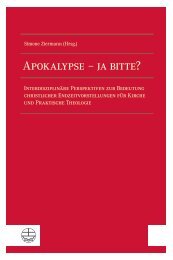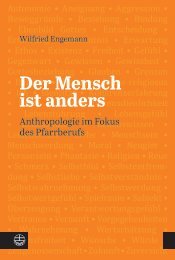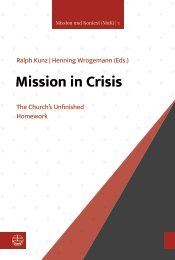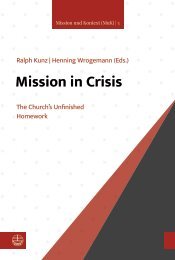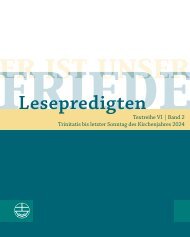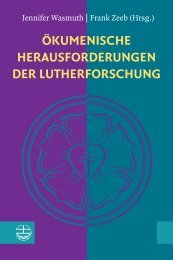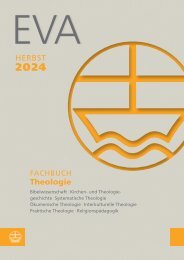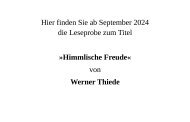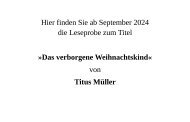Phillip A. Davis, Jr. | Daniel Lanzinger | Matthew Ryan Robinson (Eds.): What Does Theology Do, Actually? (Leseprobe)
Create successful ePaper yourself
Turn your PDF publications into a flip-book with our unique Google optimized e-Paper software.
54<br />
Athalya Brenner-Idan<br />
1. Pandemic / Epidemic in the Hebrew Bible<br />
There is no equivalent word in the HB for our ‘‘pandemic’’ or ‘‘epidemic’’. By<br />
‘‘pandemic’’ we now mean a serious health risk, seemingly spreading ever so<br />
quickly everywhere, uncontrollable, or almost so, which affects individuals but<br />
also vast collectives of numerous people, potentially fatally.<br />
In the HB, the nouns magephah or negeph 2<br />
that are usually translated as<br />
‘‘plague’’ or ‘‘pandemic’’ and at times ‘‘pestilence’’ derive from the verb n-g-ph qal,<br />
‘‘to strike, hit’’ (also in war). And the plagues of Egypt (Exodus 9) are in the Hebrew<br />
makkot, plural of makkah from n-k-h hif. etc., again ‘‘hit, strike’’.<br />
Even though a specifically designated term is missing, this does not mean<br />
that fatal (health) plagues / epidemics are not known in the HB. On the contrary.<br />
For instance, the HB narrates in three places (2 Kings 18---19; Isaiah 36---37; 2<br />
Chronicles 32) how King Sennacherib of Assyria devastated the land of Judah,<br />
but miraculously stopped his siege of Jerusalem and returned to his country<br />
without conquering the city. This journey of Assyrian punishment is assigned to<br />
701 BCE and is variously witnessed also by the extrabiblical sources of the Sennacherib<br />
Prism, archaeological findings from Lachish and Azekah, the Siloam<br />
Inscription, Flavius Josephus, Herodotus, and Berossus. Whereas the HB and<br />
later Jewish traditions present the sudden lifting of the siege as a divine miracle,<br />
external contemporaneous sources mention ‘‘plagues’’ of mice or even cholera<br />
that attacked the Assyrian troops.<br />
This instance, again, means that --- in spite of serving as headwords in different<br />
semantic fields --- both groups of terms, and the extra-linguistic concepts that<br />
underline them, are somehow connected, since they appear in both contexts of<br />
war and of epidemics. As an aside: Indeed, the exclusive specialization of<br />
magephah as ‘‘plague’’ or ‘‘pandemic’’, as separate completely from the signification<br />
‘‘military defeat’’, is --- according to the historical dictionary of the Academy<br />
for the Hebrew Language --- no younger than the 18 th<br />
century CE. And while<br />
makkah may still signify ‘‘hit, blow’’, magephah is the modern Hebrew term used<br />
for epidemic / pandemic and never for defeat in war (although the related verb<br />
is).<br />
Now, our first task will be to find out why these two clusters of n-k-h and<br />
n-g-ph -derived terms do double duty in the HB.<br />
2<br />
Throughout this article, I’ve opted to use the SBL’s so-called General Purpose method<br />
rather than the Academic method for transcribing Hebrew words (in italics), since --- in my<br />
view --- the former better conveys the Hebrew sound sense to non-Hebrew readers.





